
This page created 18 January, 2003; and last modified: 7 February 2015 (bottom four frontpiece illustrations added)

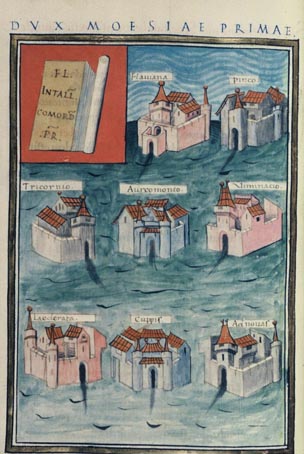 Above: Frontpiece from the Bodleian manuscript (O). The stations depicted are: Flaviana, Pinco, Tricornio, Aureomonto, Viminacio, Laederata, Cuppis, Ad Novas. Note there is a mismatch between the stations labelled here and those given as cavalry stations in the text, with Ad Novas substituting for the second mention of Pinco. |
The following units (or detachments of units) are listed as being under the command of the Duke of first Moesia (i.e. northeastern Serbia); the word "equitum" in each line indicates they are all cavalry units (the numbers beside the names refer to Ingo Maier's numbering scheme):
78.2 Cuneus equitum Constantiacorum, at Pinco along with these auxiliares units (or detachments of units):
78.11 Auxiliares Reginenses, opposite Reginam and the following (prefects and their) legionary units:
78.20 Praefectus legionis quartae Flaviae, at Singiduno |
Maier's entry 78.23 is the Praefect[us] mil. contra margum in castris augusto flavianensibus: "the Prefect of the soldiers in Fort Augusto Flavianensibus opposite Margus"; Seeck (OR.XLI.33) assumed there was a missing unit name after "mil(itum)".
The men under the Praefectus legionis septimae Claudiae are obviously part of Legio VII Claudia Pia Fidelis, that had long been stationed at Viminacium (modern Kostalac in Serbia), but in the Notitia said to be also stationed at Cuppis, while it is the Praefectus classis Histricae that is stationed at Viminiacium, along with a cuneus of equites promoti. It is likely the Septimani iuniores of the Magister Equitum's Gallic command are a detachment of Legio VII Claudia (there is a small possibility this units instead derives from Legio VII Gemina Felix, stationed in Spain).
Similarly, the men under the Praefectus legionis quartae Flaviae are part of Legio IIII Flavia Felix, which had been stationed in Moesia since the 1st century, and based at Singidunum (modern Belgrade) just as it is recorded in the Notitia, although detachments are known to have served in many regions. For example, there is an inscription (AE 1987, 964) from what is now east Jordan commemorating the construction of a road by detachments from multiple legions, including IIII FL(lavia), during the Tetrarchy (ca. 300), and coinage indicates a detachment likely served in Gaul during the reign of the Gallic Emperor Victorinus (269 - 271). It is possible that a detachment such as this may be the origin of one or more of the units in the Notitia with a "Gallicani" name; in particular the Honoriani felices Gallicani, which also bears the name "Felix". While this unit also bears the name Honorius, and thus appears at first blush to date from the 393 at the earliest, its position in the Magister Peditum's infantry roster would indicate it was raised before all the various "Flavian" legions that could only have been raised much earlier in the 4th century, indicating that Honorius probably merely refounded the unit, in much the same way as the "original" Legio IIII Flavia Felix was not actually founded in the year 70, but refounded, mostly from soldiers of the former Legio IIII Macedonica that had been disbanded earlier in the year.
In the Notitia, in some Danubian commands, such as that of the Dux Provinciae Valeriae ripensis, the legions are split between up-river ("superioris") and down-river ("inferioris") sections. Although this is the case for Moesia I in the Notitia, epigraphic evidence confirms Legio IIII Flavia was indeed so split, presumably in the past before the Notitia was drawn up. See Peter Kovacs, The late Roman army in Pannonia (2004), available here.
The Praefectus classis Histricae is in charge of a detachment of the Danubian fleet; other detachments of the same fleet are listed under the Dux Provinciae Pannoniae secundae ripariensis et Saviae, the Dux Provinciae Valeriae ripensis, the Dux Daciae ripensis, and presumably the Dux Scythiae (whose fleet detachment is not named) and the Dux Pannoniae primae et Norici ripensis (whose fleet detachments are named after their shore stations, and not after the river).
Below are shown the frontpieces from the Parisian manuscript, P; and the Froben printed edition, B:
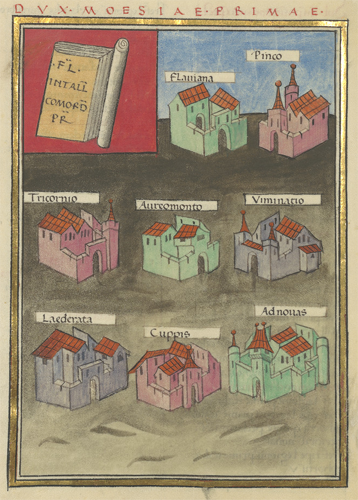
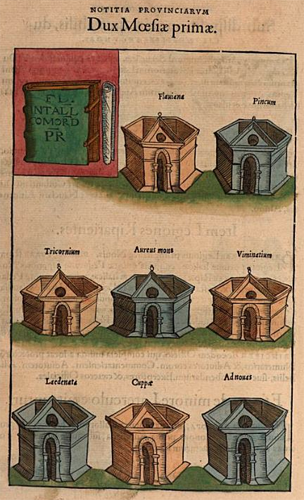
And below are shown the frontpieces from the first set of pictures in the Munich manuscript, M; and the second set, W.
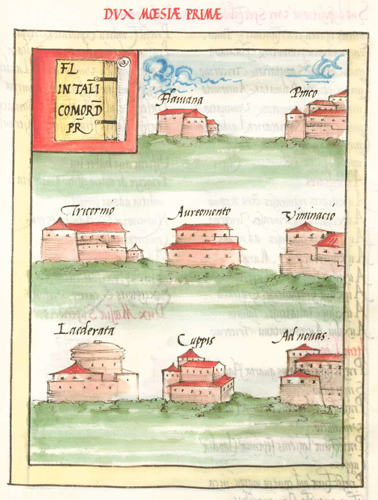
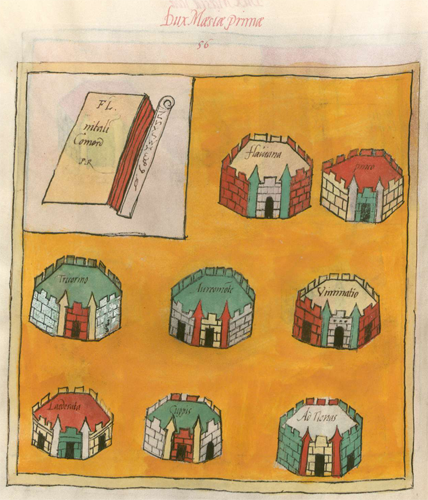

Return to the Notitia index page.